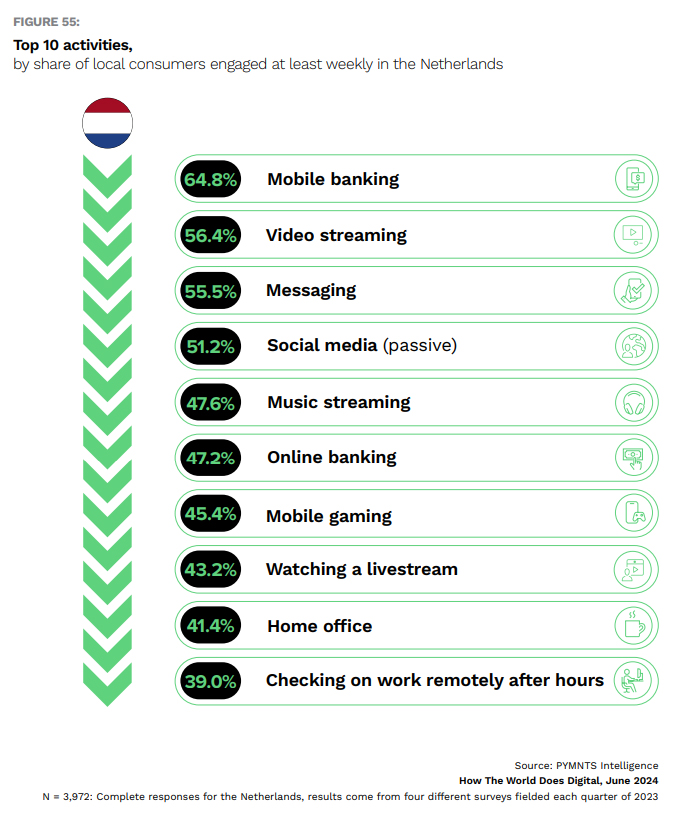
Famed for its vibrant tulips and ubiquitous bicycles, the Netherlands is proving innovation isn’t limited to pedal power. This nation, boasting the world’s largest flower export industry and more bicycles than people, is now pedaling toward digital transformation.
As the fifth-largest EU economy by GDP, with a population boasting near-universal internet access and a strong mobile banking culture, the Dutch are embracing digital transformation.
Mobile banking is the most popular digital activity, along with video streaming, messaging and social media (passive). Gen Z has the highest digital engagement, followed by millennials, Gen X and baby boomers. Meanwhile, higher-income earners tend to be more digitally active.

Netherlands ranks ninth among 11 surveyed countries in PYMNTS Intelligence’s “How the World Does Digital” report, which analyzes the digital behaviors of over 817 million consumers across countries such as Brazil, Singapore, the United States, Spain and Italy. The report delves into various aspects including banking, shopping, communication and entertainment.
Mobile banking emerges as the most popular digital activity among Dutch citizens, with 64.8% of the population engaging in it weekly. Connecting to its strong mobile banking culture, Netherlands launched an online payment network, IDEAL, which allows consumers to pay online from their bank accounts.
Video streaming (56.4%), messaging (55.5%), passive social media (51.2%), and music streaming (47.6%) comprise the top five weekly digital activities.
Rounding out the Top 10 weekly digital activities are online banking (47.2%), mobile gaming (45.4%), watching a livestream (43.2%), home office (41.4%), and checking on work remotely after hours (39.0%).
In terms of monthly engagement, mobile banking heads the list with an average of 14.2 days per month. Messaging (14.1 days), video streaming (13.9 days), passive social media (13.1 days), and music streaming (12.0 days) make up the top five monthly digital activities.
Completing the top 10 monthly activities are mobile gaming (11.8 days), online banking (11.1 days), watching a livestream (10.9 days), home office (9.8 days), and checking on work remotely after hours (9.5 days).
Gen Z is the runaway leader for highest digital engagement (421 activity days) among generations, followed by millennials (354 days), Gen X (246 days), and baby boomers (138 days). High-income earners are the most digitally active (274.6 days), followed closely by middle-income (274.0 days) and low-income earners (238.7 days).
The Dutch Digitalisation Strategy 2.0 focuses on improving digital skills across all levels of Dutch society, from citizens to information and communication technologies (ICT) professionals. Their work involves developing, operating, and maintaining the IT systems that are critical for businesses and institutions to function. The strategy acknowledges the need to grow this talent pool to keep pace with the country’s digitalization goals.
The strategy aims to bolster the ICT professional pool through partnerships between businesses and schools, and by attracting international talent. Finally, it focuses on education by encouraging digital innovation and literacy among educators and students, while ensuring secure IT infrastructure.
The Netherlands boasts a highly digital society with a strong foundation in basic digital skills (82.7%, highest in EU). But the country recognizes the need to bridge the gap for those left behind. While the ICT specialist workforce is growing (6.9% of employed population), filling these roles remains a challenge, particularly attracting women (less than 25%). Additionally, artificial intelligence (AI) adoption by businesses (13.4%) is above the EU average, but recent growth lags the EU.
Despite these areas for improvement, the Dutch roadmap is ambitious. It allocates a significant budget (€4.9 billion) and sets specific targets aligned with the EU’s 2030 digital goals. Meanwhile, public perception is encouraging: 45% of Dutch citizens trust the EU to protect their digital rights, and confidence in digital privacy is high (54%).